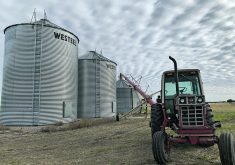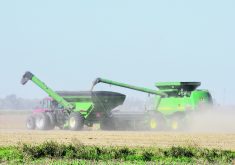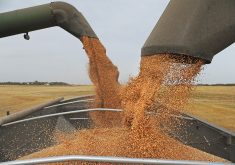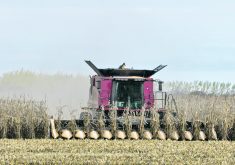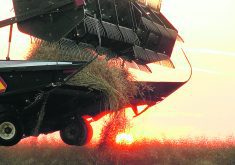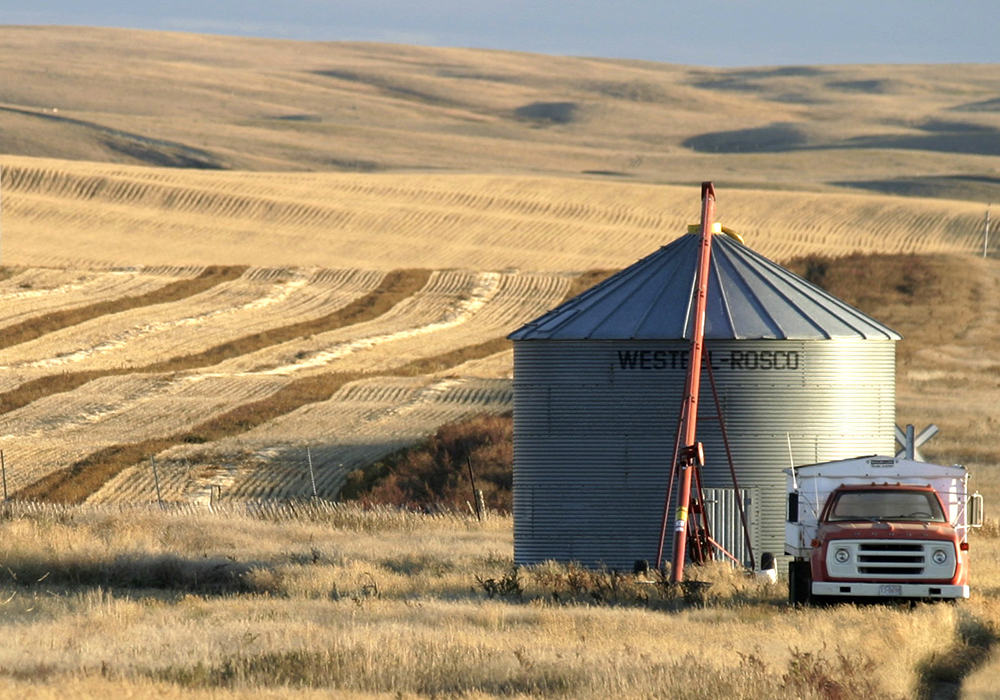Manitoba
SOUTHWEST
Crops continue to improve as a result of mild and drier weather, but long-term yields are expected to be average.
Precipitation was five to 15 millimetres, while temperatures were at ideal levels for crop development.
The drier, less humid conditions are helping keep disease levels for most crops at low to moderate levels.
There’s evidence of fusarium head blight in winter wheat, root rot in field peas and brown girdling root rot in canola caused by excess moisture early in the season.
Read Also

Farming Smarter receives financial boost from Alberta government for potato research
Farming Smarter near Lethbridge got a boost to its research equipment, thanks to the Alberta government’s increase in funding for research associations.
Spraying for sclerotinia stem rot in canola has declined.
Wheat midge is on the increase, but concern is decreasing because many wheat fields are flowering.
Soybeans are flowering and in the R1 to R4 stage. Corn growth varies because of excess moisture.
Forage crops are yielding average to above average, while quality varies from above average to below average. Native hay pastures remain in good condition.
NORTHWEST
Crops are improving thanks to warmer and drier conditions but are about two weeks behind normal development for this time of year. Rainfall amounts varied from trace to more than 76 mm.
Most cereal crops are in the heading and flowering stage with the rest in the milk stage. Almost all canola is flowering. More than half of all soybeans are flowering. Three-quarters of field peas have podded.
Fungicide applications are mostly done. Wild oats can be seen in some cereal crops.
Insect pressure remains low.
Many fields have wet spots, but haying operations have progressed well. Yields are average to above average with average quality.
CENTRAL
Crops are looking good, other than in areas with excess moisture. Rain was generally welcomed and varied from 10 to 50 mm. Days were sunny and warm, but low overnight temperatures slowed crop growth.
Irrigation has begun on potatoes, and cereals are fully headed. Canola is from full flower to full pod, while most soybeans are flowering. Edible beans are showing iron chlorosis in areas of excess moisture. Corn growth varies but is improving.
Wild oats can be seen in many cereal crops. Green and yellow foxtail and barnyard grass are evident, as is volunteer canola.
Fungicide applications are nearly complete for cereals with reports of more acres treated, but many later seeded canola fields did not require fungicide treatment. Spraying for white mold in dry beans continues in some fields. Sunflowers will begin receiving fungicide applications for head rot.
Some fusarium head blight is evident in spring wheat. Blasting and wild oats have been found in all oat varieties. Blackleg lesions are on leaves in many canola fields. Brown girdling root rot and other root rots are reported in some fields. Some bacterial blight is evident in soybeans and edible bean fields.
Insect activity remains low for most fields and crops.
Tame forage yields are average to above average. Good yields are expected with alfalfa silage.
EASTERN
Crops, particularly soybeans, are responding well to warmer and drier conditions. Rainfall was three to 35 mm. Standing water is quickly dissipating.
Desiccation of advanced winter wheat crops has begun. Some fungicides were applied on later seeded canola and cereals, and applications have continued for soybeans. Soybeans have also received final applications of glyphosate.
There are reports of grasshopper flare-ups with producers spraying. Scouting for insect populations are ongoing but generally have not warranted insecticide applications.
INTERLAKE
Warmer and drier conditions have helped crop development, but crops vary from very poor to good. Less than average yields in certain areas are expected.
Rainfall amounts were three to 10 mm.
Winter wheat will soon be desiccated, and most spring cereals have headed and flowered. Sunflowers have started flowering and corn is tasseling. Soybeans are flowering with pods starting to form. Forage grass seed will soon be ready for swathing. Some earlier grasses have already been cut.
Saskatchewan
SOUTH
Crops are progressing well in the east, but storms caused havoc in the west. Heavy rain, strong winds and hail caused crop loss, blew around hay swaths, overturned bins and damaged homes and vehicles.
Rainfall varied from small amounts to 42 mm in the Glenavon area. The Maryfield area leads the region with 469 mm of cumulative precipitation since April 1.
Rain and humidity have delayed some producers, but haying is advancing well with half to three-quarters of the crop baled or put into silage. More has been cut and ready for baling. More than three-quarters of the hay crop is good quality.
Cropland topsoil moisture conditions are rated more than 75 percent adequate while hay land and pasture topsoil moisture conditions average 75 percent adequate.
Some producers continue to spray for fusarium head blight, sclerotinia and leaf spots. Others are spraying for grasshoppers in lentil and flax crops. Root rot is prevalent, particularly in lentils and peas.
CENTRAL
Warm and dry weather is advancing crops and haying operations, but crops are still behind their normal stages of development.
Livestock producers have baled half of their hay crop or put it into silage, with an additional 25 percent cut and ready for baling.
However, recent rain and high humidity have slowed haying operations and reduced quality, which is rated more than 80 percent good.
The Kindersley area topped the region for most rainfall at 92 mm while the Foam Lake area leads with 529 mm since April 1.
Topsoil moisture conditions on cropland, hay and pastures are rated at more than 80 percent adequate.
Many producers continue to spray for diseases such as leaf spots and sclerotinia as well as for wheat midge and grasshoppers in lentils. There are also reports of high plant loss in pulse crops caused by root rot.
NORTH
Crops continue to trail normal development, and warm, dry conditions are needed to mature crops.
The Frenchman Butte area led the region with 64 mm of rain while the Hafford area has received the most rain since April 1 with 421 mm.
Haying continues despite the wet, humid conditions, and producers have either baled or put into silage half of the crop. One-quarter of the hay crop has been cut and ready for baling. Quality is averaging 80 percent good.
Most crop damage was caused by wind, localized flooding and hail damage. Producers continue spraying for sclerotinia, fusarium head blight and leaf spots.
Alberta
SOUTH
The region experienced hot, dry weather and most crops are ratedin good condition.
Spring cereals are in the late pollination stage and winter cereals in soft dough. About three-quarters of canola is podding while most field peas are podding.
Most of the sub-soil moisture is rated as good to excellent.
The first cut of hay on dryland and irrigated land is almost complete with most hay and pastures rated good to excellent.
CENTRAL
Fifteen to 50 mm of much needed precipitation fell. Spring cereals are in the mid-pollination stage and winter cereals are in early dough. More than half the canola is podding and three-quarters of field peas are podding.
Most sub-surface soil moisture is slightly down but still rated in good or excellent condition.
Almost all the first cut of dryland hay is complete. More than half of hayland and pastures are in good or excellent shape.
NORTHEAST
Moisture ranging from light showers to 50 mm was beneficial for yield and maturity. Most crops are in good to excellent condition and much higher than the five year average.
Spring cereals are in late pollination and winter cereals in soft dough. About 70 percent of canola is podding while more than 90 percent of field peas are podding.
Almost all of the sub-surface soil moisture is rated in good to excellent condition.
Most of the first cut of dryland hay is complete. Hayland and pastures are in good to excellent condition.
NORTHWEST
Precipitation was 25 to 50 mm with most crops now entering the kernel filling stage.
Spring cereals are in the early milk stage while more than three-quarters of canola and field peas are podding.
About half of the sub-soil moisture condition is rated good or excellent, while almost all of the surface soil is excellent.
PEACE
Much of the region received 15 to 35 mm of rain. Most crop conditions are 50 percent good to excellent.
Spring cereals are in the early milk stage. Most canola and field peas are podding.
Sub surface soil moisture remains unchanged from the previous week with more than half rated good to excellent.
First cut of hay is almost complete. Hayland and pastures are more than 50 percent good or excellent.




